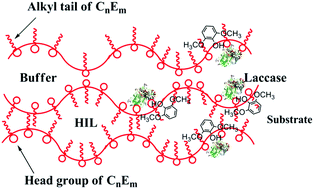Study on the catalytic performance of laccase in the hydrophobic ionic liquid-based bicontinuous microemulsion stabilized by polyoxyethylene-type nonionic surfactants†
Abstract
To formulate a compatible green medium for the conversion of a hydrophobic substrate by a hydrophilic enzyme, we investigated the phase behavior of pseudo ternary hydrophobic ionic liquid (HIL)/buffer/polyoxyethylene-type nonionic surfactant (CnEm)/n-alcohol system and the effects of the components on the formulation of the HIL-based bicontinuous microemulsion. It is found that small head group of the surfactant, high concentration of n-alcohol (medium/long alkyl chain) and low cohesive energy density of the HIL result in low phase transition temperature. In the CnEm stabilized compatible bicontinuous microemulsion, the kinetics of laccase catalyzed oxidation of 2,6-dimethoxyphenol were also investigated. It is found that in addition to temperature, n-alcohol is the key parameter affecting the catalytic performance of laccase, and the optimum n-alcohol depends on the type of HIL as an oil phase. All the kinetic parameters, such as Km, kcat, kcat/Km, and Ea (apparent activation energy), indicate that the bicontinuous microemulsion consisting of [Omim]NTf2/buffer/CnEm/n-hexanol is a suitable medium for the laccase-catalyzed reaction. To the best of our knowledge, this is the first report on the formulation of HIL-based bicontinuous microemulsion for enzyme catalysis.


 Please wait while we load your content...
Please wait while we load your content...